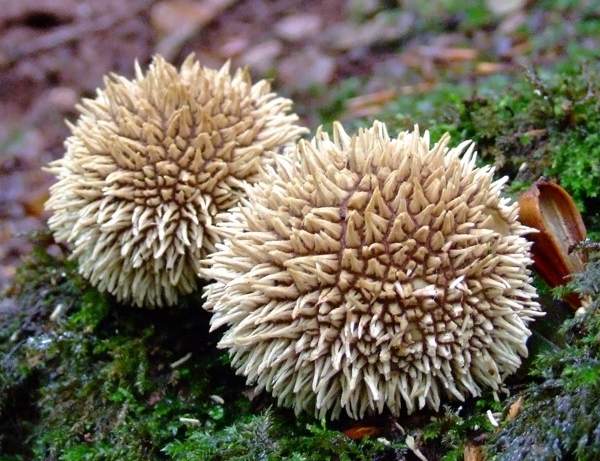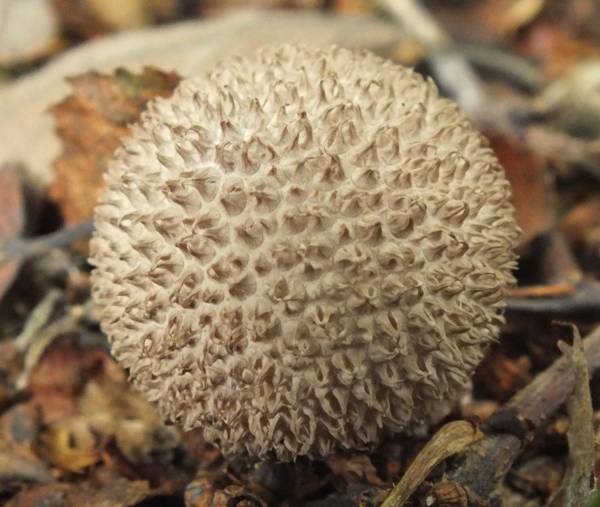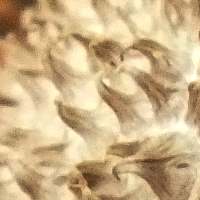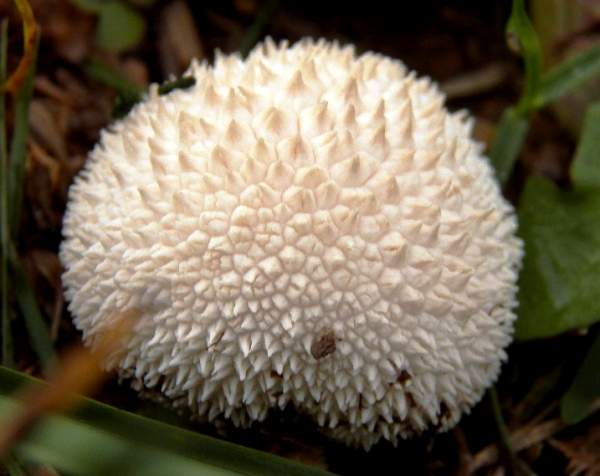Trees Birds Mammals Fish Amphibians Reptiles
Wild Algarve
Bookshop
Lycoperdon echinatum Pers. - Spiny Puffball
Phylum: Basidiomycota - Class: Agaricomycetes - Order: Agaricales - Family: Agaricaceae
Distribution - Taxonomic History - Etymology - Identification - Culinary Notes - Reference Sources

Lycoperdon echinatum, the Spiny Puffball, has a
small, globe-shaped head on a very short stipe. The soft reddish-brown
spines are in groups of threes. The fine specimen shown here was photographed by Doug Holland to whom we are grateful for permission to show the picture.
Distribution
Lycoperdon echinatum is uncommon in most parts of Britain and Ireland, where it is found most often in beech woodland on alkaline soil. This inedible puffball also occurs in parts of mainland Europe and in North America.

Above is a Spiny Puffball found in Devon, UK; it is a little older and therefore noticeably darker than the younger specimen shown above. As they age the exoperidia (outer skins) of Spiny Puffballs turn darker and tend to lose their spines.
Despite lacking gills, puffballs are now known to be very closely related to the so-called 'true mushrooms', Agaricus species, which include such prized edibles as The Prince, Field Mushroom, and Horse Mushroom. It should come as no surprise, therefore, that some puffballs species (but not this one!) are edible and very good to eat as long as they are gathered while young and still pure white throughout.
Once the spore mass turns olive, edible puffballs are not good to eat - although try telling that to slugs, such as the hungry muncher seen in the top left of the picture opposite!.
Taxonomic history
Lycoperdon echinatum was described and in 1801 by Christiaan Hendrik Persoon, who gave it the scientific name that it has retained to this day. Among its synonyms are Lycoperdon hoylei Berk. & Broome, Utraria echinata (Pers.) Quél., and Lycoperdon americanum Demoulin.
Etymology
The specific epithet echinatum comes from the Greek word echinos meaning ‘hedgehog’ or ‘sea-urchin’. (There is a difference!).
The genus name Lycoperdon literally means 'wolf's flatulence' and begs the question who got close enough to a wolf to become an expert on the matter. For most of us, surely such an odour cannot be considered a particularly helpful diagnostic feature for identifying the Spiny Puffball, Lycoperdon perlatum.
Identification guide
 |
Fruitbody
Typically 2.5 to 5cm across; 3 to 7cm tall; spines typically 4 to 5mm long. A vertically-flattened globe-shaped fruitbody
on a short, infertile stem; initially white, soon becoming reddish brown.
The soft spines are in sets of three (or occasionally groups of four) that converge at the tips. At maturity the spines fall off leaving a net-like pattern on the
browning skin, which eventually ruptures at the apex to release the
spores.
Stem
None. |
| |
Spores
Roughly spherical, 3.5-5.1µm diameter; ornamented with small warts.
Spore mass
Very dark purple-brown. |
Odour/taste |
Not distinctive. |
Habitat & Ecological role |
Saprobic, mainly found in beech woodland in chalk and
limestone areas. |
Season |
July to November in Britain and Ireland. |
Similar species |
Lycoperdon perlatum is paler and covered in warts rather than
spines.
Lycoperdon nigrescens has a longer stem; its flesh has a faint but unpleasant odour.
Lycoperdon mammiforme is white at first and then its surface
breaks up into large cream scales rather than spines. |

Culinary notes
Although many puffball species are considered good edible fungi the Spiny Puffball is not one of them, and so if gathering puffballs to eat it is important to avoid these very distinctive members of the genus, which in any case are rare in most parts of Britain and Ireland.
For a very easy to recognise edible puffball that cannot be mistaken for any other mushroom, see Calvatia gigantea, the Giant Puffball. Unfortunately it's not every day that you stumble across Giant Puffballs, as they are not only uncommon but also very localised in their distribution. If you find a good spot for these mighty meaty meal sources, make a note of it because Giant Puffballs, like Common Puffballs, usually reappear in the same places for many years.
Reference Sources
Fascinated by Fungi, 2nd Edition, Pat O'Reilly 2016, reprinted by Coch-y-bonddu Books in 2022.
Pegler, D.N., Laessoe, T. & Spooner, B.M (1995). British Puffballs, Earthstars and Stinkhorns. Royal Botanic Gardens, Kew.
British Mycological Society. English Names for Fungi
Dictionary of the Fungi; Paul M. Kirk, Paul F. Cannon, David W. Minter and J. A. Stalpers; CABI, 2008
Taxonomic history and synonym information on these pages is drawn from many sources but in particular from the British Mycological Society's GB Checklist of Fungi.
Acknowledgements
This page includes pictures kindly contributed by Doug Holland, David Kelly and David Walker.
Top of page...
Fascinated by Fungi. Back by popular demand, Pat O'Reilly's best-selling 450-page hardback book is available now. The latest second edition was republished with a sparkling new cover design in September 2022 by Coch-y-Bonddu Books. Full details and copies are available from the publisher's online bookshop...